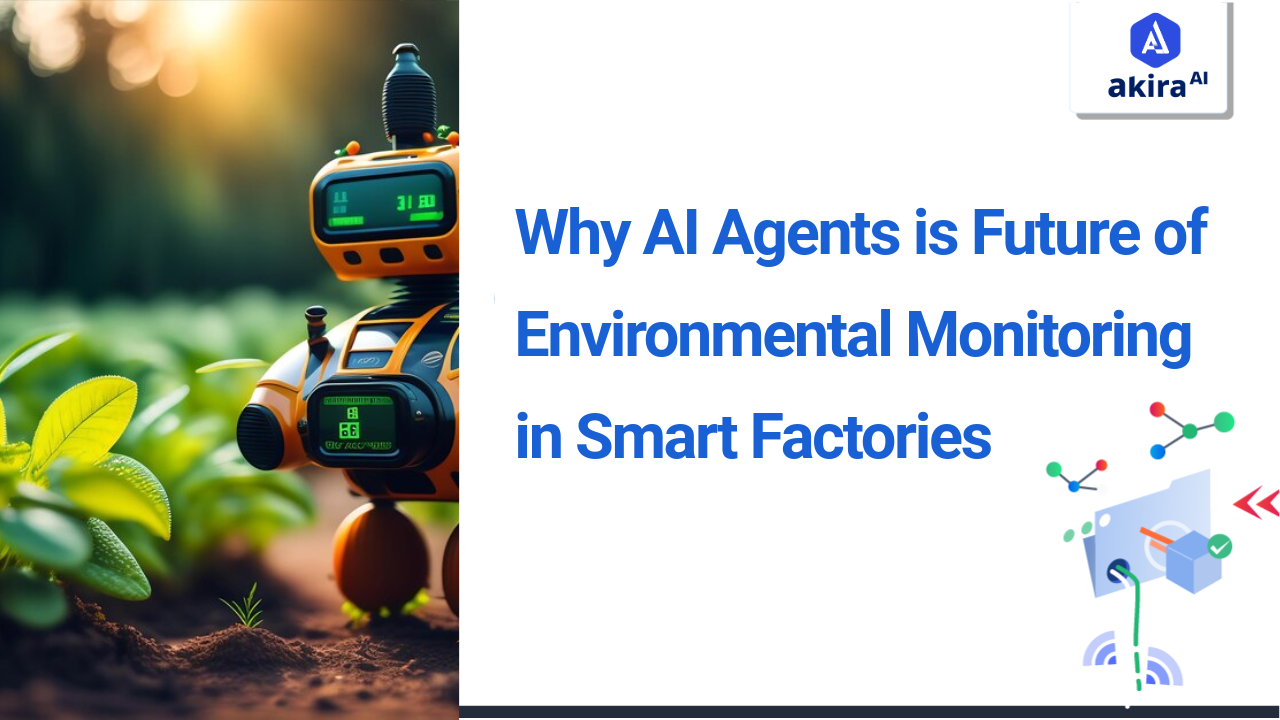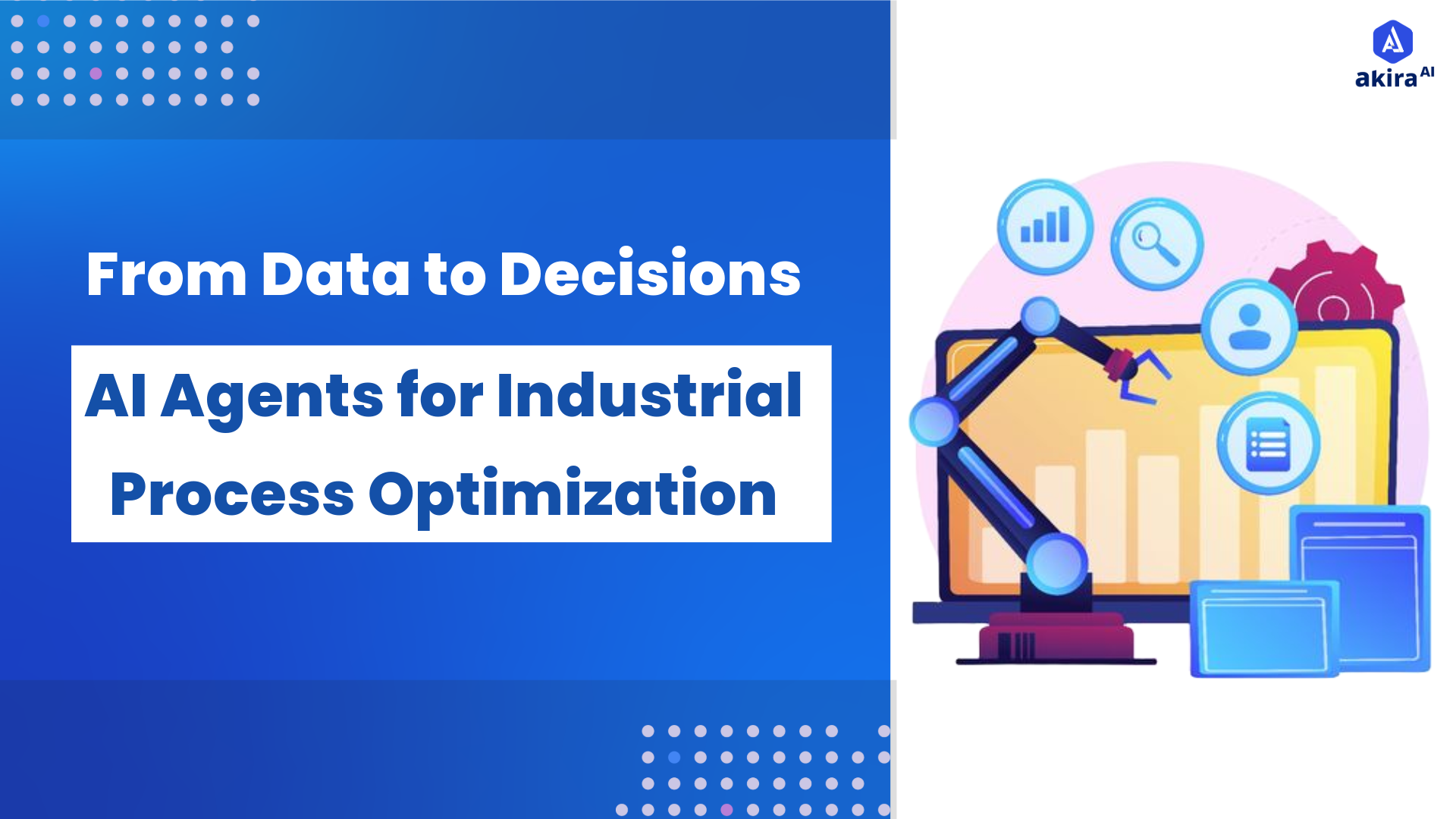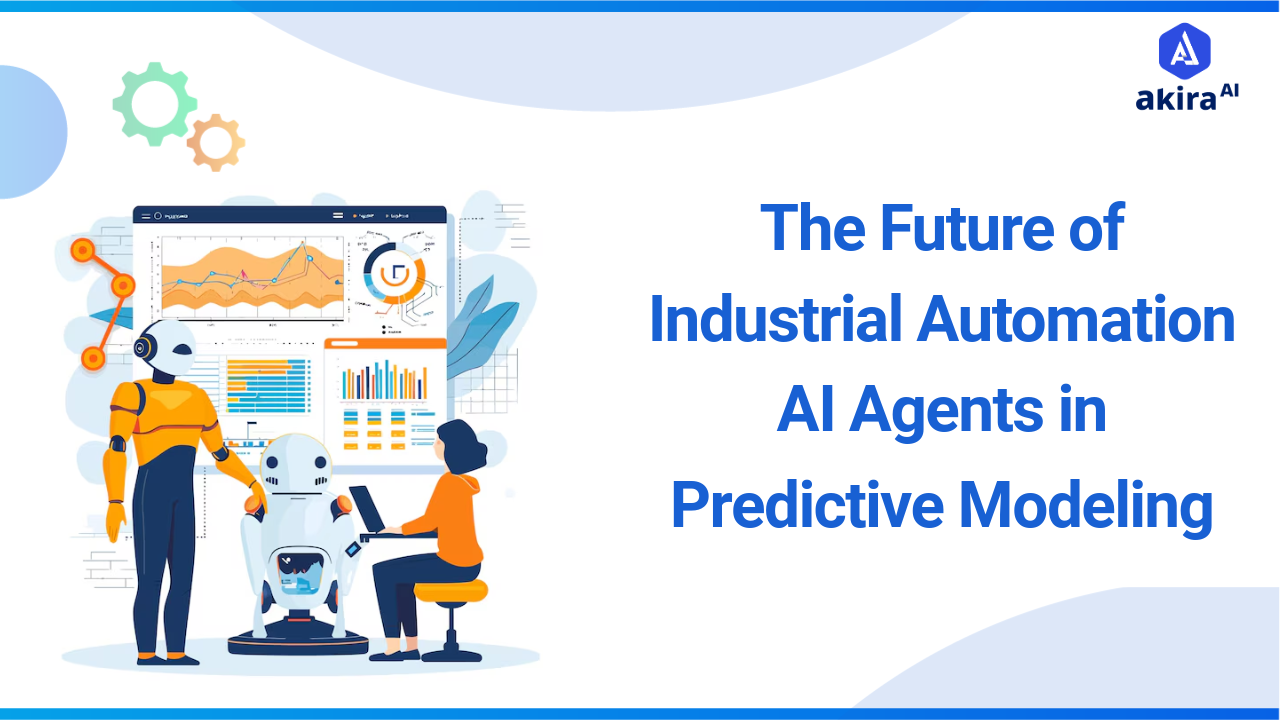Key Insights
-
AI-driven Environmental Monitoring optimizes air quality, energy usage, and waste management for improved efficiency and sustainability.
-
Regulatory Compliance is ensured through real-time tracking and automated reporting of environmental data.
-
AI Agents will integrate green technologies, predictive climate risk management, and decentralized monitoring for more innovative manufacturing.

As industries strive for sustainability and efficiency, smart factories require advanced solutions for environmental monitoring. Traditional methods often lack real-time adaptability, leading to inefficiencies and compliance risks. AI agents are revolutionizing this space by offering autonomous tracking, predictive analytics, real-time air quality optimisation, energy usage, and waste management.
Leading manufacturers already leverage Agentic AI-driven systems to enhance regulatory compliance, reduce energy consumption, and minimize environmental impact. This blog explores how AI agents transform ecological control, the benefits they bring to industrial operations, and why they represent the future of smart, eco-friendly manufacturing. The shift towards AI-driven monitoring is not just an innovation—it's a necessity for the factories of tomorrow.
What is Environmental Monitoring and Control in Factories?
In the world of Industry 4.0, Environmental Monitoring and Control (EMC) in factories refers to the systematic process of tracking, analyzing, and regulating environmental conditions within industrial settings. It involves monitoring air quality, temperature, humidity, noise levels, waste disposal, and energy consumption to ensure safety and compliance with environmental regulations. EMC helps minimize pollution, protect worker health, and optimize production efficiency.
It plays a crucial role in sustainable manufacturing, ensuring minimal impact on natural resources while enhancing operational efficiency. Effective EMC strategies prevent equipment failures, improve product quality, and contribute to corporate social responsibility initiatives. EMC is essential for creating a safer, greener, and more efficient industrial environment.
Key Concepts of Environmental Monitoring
The concept of AI agents in environmental monitoring involves several crucial components that enable efficient and intelligent factory management:
Air Quality Monitoring – Tracks airborne pollutants and ensures compliance with environmental regulations.
Temperature and Humidity Control – Maintains optimal conditions to prevent equipment malfunctions and ensure worker comfort.
Waste and Water Management – Monitors wastewater discharge and chemical waste disposal and promotes sustainable waste reduction.
Noise and Vibration Monitoring – Reduces excessive noise exposure and ensures workplace safety compliance.
Energy Consumption Monitoring – Tracks energy usage to optimize efficiency and reduce operational costs.
Regulatory Compliance – Ensures adherence to environmental laws and industry standards.
IoT and Automation in EMC – Uses innovative monitoring systems for real-time data collection and automated adjustments
Traditional Way of Environmental Monitoring and Control in Factories
Before the rise of AI Agents, factories relied on more conventional methods for environmental monitoring and control. These methods were often manual or semi-automated and had several limitations:
-
Manual Monitoring: In traditional factories, human operators would often be responsible for observing environmental conditions. They would manually check data points such as temperature, air quality, and energy consumption and adjust based on these observations.
-
Scheduled Inspections: Many factories relied on scheduled inspections, where workers checked specific systems or instruments at fixed intervals. While functional, this process was not ideal for preventing unexpected changes in the environment, such as sudden temperature spikes or air quality dips.
-
Simple Control Systems: Some factories had centralized control systems that monitored environmental factors, but these systems could not make real-time adjustments. They would often adjust the environment based on preset conditions, which could lead to inefficiencies or waste.
-
High Reliance on Human Intervention: The traditional approach required continuous oversight by human operators, leading to higher labour costs and slower response times to environmental changes.
While effective at times, these traditional methods were inefficient in the modern manufacturing world, where speed, cost-effectiveness, and sustainability are critical.
Impact on Customers Due to Traditional Way
The traditional environmental control methods directly impact factory operations and the customers who depend on those operations. Some of the significant consequences include:
-
Inefficiencies in Resource Utilization: Traditional systems often result in energy overconsumption, leading to higher operational costs. For example, inefficient HVAC systems may run unnecessarily, consuming more energy than needed, directly increasing factory overheads and, in some cases, product prices.
-
Delayed Response to Environmental Changes: Since traditional systems could not adjust quickly to real-time changes, factories could experience delays in responding to sudden environmental shifts. This may lead to production inefficiencies, quality issues in manufactured goods, and missed deadlines, impacting customer satisfaction.
-
Regulatory Non-Compliance: Environmental regulations are becoming increasingly stringent, and traditional systems may not provide the real-time monitoring and reporting needed for compliance. Non-compliance with environmental laws can result in fines, penalties, and reputational damage, ultimately affecting customers.
-
Sustainability Concerns: Sustainability is a growing priority for businesses and consumers alike. Traditional monitoring methods often result in higher energy usage and waste production, contradicting sustainability goals. This can tarnish a company's reputation among eco-conscious customers.
Akira AI: Multi-Agents in Action
Akira AI functions across multiple levels of factory operations, integrating data from various sources, processing it through intelligent algorithms, and making autonomous decisions. Below is a horizontal architecture diagram to illustrate how the system operates:
 Fig1: Architecture Diagram of Environmental Monitoring and Control
Fig1: Architecture Diagram of Environmental Monitoring and Control
1. Data Collection from Multiple Sources: Various sensors, including telematics devices, factory machine sensors, and smartphone GPS & vehicle sensors, continuously collect real-time data on energy consumption, air quality, temperature, humidity, machine efficiency, and equipment status.
2. Master Orchestrator Agent Coordination: The Master Orchestrator Agent processes all incoming data, ensures smooth communication between systems, and directs specialized AI agents to take appropriate real-time actions for optimizing environmental and operational conditions.
3. AI Agents Analyze and Optimize Operations
-
Factory Machine Efficiency Agents analyze machine performance, prevent overuse, and adjust schedules to minimize energy consumption.
-
Predicting Environmental Risk Agents use predictive analytics to detect potential risks, such as air quality deterioration or high-energy usage periods, and take preventive measures.
-
Identifying Anomalies in Factory Data Agents detect irregularities, such as unexpected temperature spikes or abnormal energy use, and trigger real-time corrective actions.
4. Automated Adjustments and Decision-Making
AI agents autonomously adjust HVAC settings, machine operations, and energy usage based on real-time data, reducing costs, preventing inefficiencies, and optimizing waste management processes to enhance factory sustainability.
5. Performance Evaluation and External System Integration
Environmental Performance Evaluation Agents assess energy efficiency and sustainability. Regulatory Compliance and Reporting Agents ensure adherence to environmental laws, and the AI system integrates with external energy grids and management platforms to further optimize operations, reduce costs, and maintain compliance.
Prominent Technologies in the Space of Environmental Monitoring
Before the advent of AI agents, a variety of other technologies were deployed in factories for environmental monitoring:
-
IoT-Based Smart Sensors – Real-time data collection on air quality, temperature, humidity, and emissions helps industries monitor environmental conditions and make instant adjustments.
-
Machine Learning – Advanced analytics predict environmental risks, detect anomalies, and optimize factory operations to enhance sustainability and efficiency.
-
Big Data and Cloud Computing – Large-scale environmental data processing enables better decision-making, trend analysis, and compliance tracking through centralized platforms.
-
Edge Computing – On-site data processing reduces latency, allowing real-time environmental adjustments without relying on external servers.
-
Remote Sensing & Drones – Satellite imagery and drone-based monitoring provide large-scale environmental tracking, detecting pollution, deforestation, and climate change.
While all these technologies have contributed to factory optimization, none offer the complete package of autonomous, real-time decision-making capabilities that AI agents provide.
AI agents are driving the future of sustainability by optimizing resource efficiency, minimizing waste, and enabling smarter, data-driven decision-making for a greener planet.
How AI Agents Supersede Other Technologies
AI agents surpass traditional environmental monitoring technologies in several critical areas:
-
Autonomous Environmental Management: Agentic AI-driven systems will move beyond monitoring to actively controlling environmental factors, automatically adjusting factory conditions, emissions, and energy usage without human intervention.
-
Hyper-Personalized Environmental Optimization: AI Agents will tailor environmental conditions to specific operational needs, dynamically adjusting air quality, temperature, and energy use for efficiency and sustainability.
-
AI-Powered Climate Risk Forecasting: Advanced predictive models will assess long-term environmental trends, allowing industries to mitigate risks related to climate change, extreme weather, and resource depletion.
-
Decentralized AI for Large-Scale Monitoring: Distributed AI systems will analyze environmental data from multiple sources, including satellites, IoT sensors, and industrial machines, providing real-time global insights for better policy-making.
-
Seamless AI Integration with Green Technologies: AI will work alongside renewable energy sources, carbon capture systems, and circular economy models to optimize sustainability efforts and reduce environmental footprints.
Successful Implementations of AI Agents in Environmental Monitoring
-
Siemens is one of the leaders in implementing AI-driven environmental control in factories. Their factories use AI agents to optimize energy usage, monitor air quality, and reduce waste production. Siemens reports that these AI-driven optimizations have led to significant cost savings and enhanced sustainability in their operations.
-
General Electric (GE) uses AI agents to maintain optimal environmental conditions in their manufacturing plants. These agents help reduce energy consumption, monitor ecological variables, and ensure compliance with regulatory standards, ultimately improving productivity and sustainability.
-
Another real-world example is BMW, which has integrated AI agents into its production lines to manage lighting and climate control. By doing so, BMW has reduced energy costs and environmental impact while ensuring their production environments remain ideal for vehicle assembly.
Final Thoughts on AI Agents for Environmental Monitoring
AI agents are transforming environmental monitoring and control within factories, providing unprecedented levels of efficiency, sustainability, and operational optimization. By leveraging AI’s ability to analyze vast amounts of data and make autonomous decisions, factories can ensure they meet sustainability goals while maximizing production quality and minimizing waste.
As more factories adopt AI-driven systems, we expect to see a future where manufacturing is more innovative and environmentally responsible, benefiting businesses, customers, and the planet.
Next Steps with AI Agents
Talk to our experts about how AI Agents are shaping the future of environmental monitoring in smart factories, enabling real-time automation, predictive insights, and sustainable operations for enhanced efficiency and compliance


